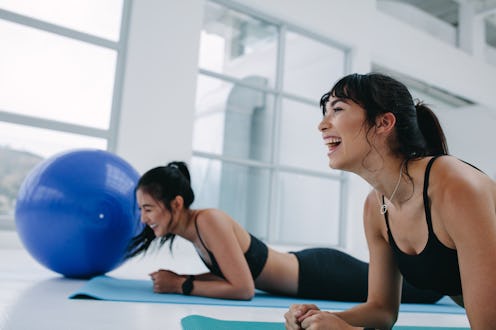Fitness
How To Do FitTok's Plank Dance Challenge Like A Pro
Just when you thought holding a regular plank couldn't get any more difficult.

Just when you thought holding a plank couldn’t get any more difficult, TikTok has to go and create a whole plank dance challenge to take your core workout to the next level. While this trend is super tough, making your plank dance somehow manages to be fun — and it also brings more benefits than a classic stationary plank.
The plank dance challenge, which has over 19 million views on TikTok, is all about holding a high plank while you jump your legs in and out and lift your arms up and down to the beat of a song. It’s like a regular dance routine, only... well, it’s horizontal and works your core. The idea is to light up different muscle groups, sneak in some cardio, and add a sprinkle of coordination skills while hopefully distracting yourself from the burn that’s happening in your arms, legs, and core.
While you can technically do a plank dance to any upbeat tune, the one you’re most likely to hear on TikTok is “Dear Future Husband” by Meghan Trainor. It’s fun, it’s bouncy, and, if you match your dance moves to the tempo, you’re bound to get an exhilarating workout. Here are all the benefits of the plank dance challenge, plus how to do it.
How To Do The Plank Dance Challenge
To kick off your plank dance workout, take a deep breath, turn on “Dear Future Husband”, and get ready to move all of your limbs at once.
- Start in a high plank with your hands planted under your shoulders and your legs extended back behind you. As the chorus starts, engage your core and do plank jacks by jumping your feet out and in.
- At the same time, add plank shoulder taps by bringing one hand to your opposite shoulder and then alternating. Repeat two times on each side to the beat.
- Next, keep your plank jacks going as you extend one arm forward, then out to the side two times. Repeat the same motion with your other arm.
- Plant both hands back down in a high plank and quickly bring a knee in towards your opposite elbow for a modified mountain climber/oblique twist combo. Repeat twice on each side.
- To finish the challenge, continue your plank jacks as you lower into a push-up. Phew!
The Benefits Of The Plank Dance Workout
A plank primarily targets your core muscles, says Ashley Iwanicki, a fitness instructor and founder of The Collective Studios, but it also recruits your shoulders, back, glutes, and leg muscles. Any plank — whether it’s a standard plank or a forearm plank — also calls on your stabilizer muscles, she previously told Bustle, which are the smaller muscles that work together to help hold you steady.
Steadiness is important as you do the plank dance challenge since you spend quite a bit of it balanced on only two limbs at a time thanks to the arm extensions, plank jacks, and mountain climbers. Your core has to work overtime to keep you upright while you extend your arms or bring a knee to your elbow. These bouncy moves add a mini cardio workout that you wouldn’t normally get during a standard plank hold.
When you incorporate plank shoulder taps, you’re giving your arms a nice workout, too, Cheryl Russo, CPT, a certified personal trainer, previously told Bustle. That’s because your bicep muscles contract to bend your arm to tap your shoulder, she explains, while your triceps engage to hold you up. Add in the push-up at the end and you have yourself a pretty solid routine. It might not be a workout you nail on the first attempt, but it’s definitely worth a try.
Studies referenced:
Byrne, JM. (2014). Effect of using a suspension training system on muscle activation during the performance of a front plank exercise. J Strength Cond Res. doi: 10.1519/JSC.0000000000000510.
Park, DJ. (2019). Which trunk exercise most effectively activates abdominal muscles? A comparative study of plank and isometric bilateral leg raise exercises. J Back Musculoskelet Rehabil. doi: 10.3233/BMR-181122.
Sources:
Ashley Iwanicki, fitness instructor, founder of The Collective Studios
Cheryl Russo, CPT, certified personal trainer
This article was originally published on